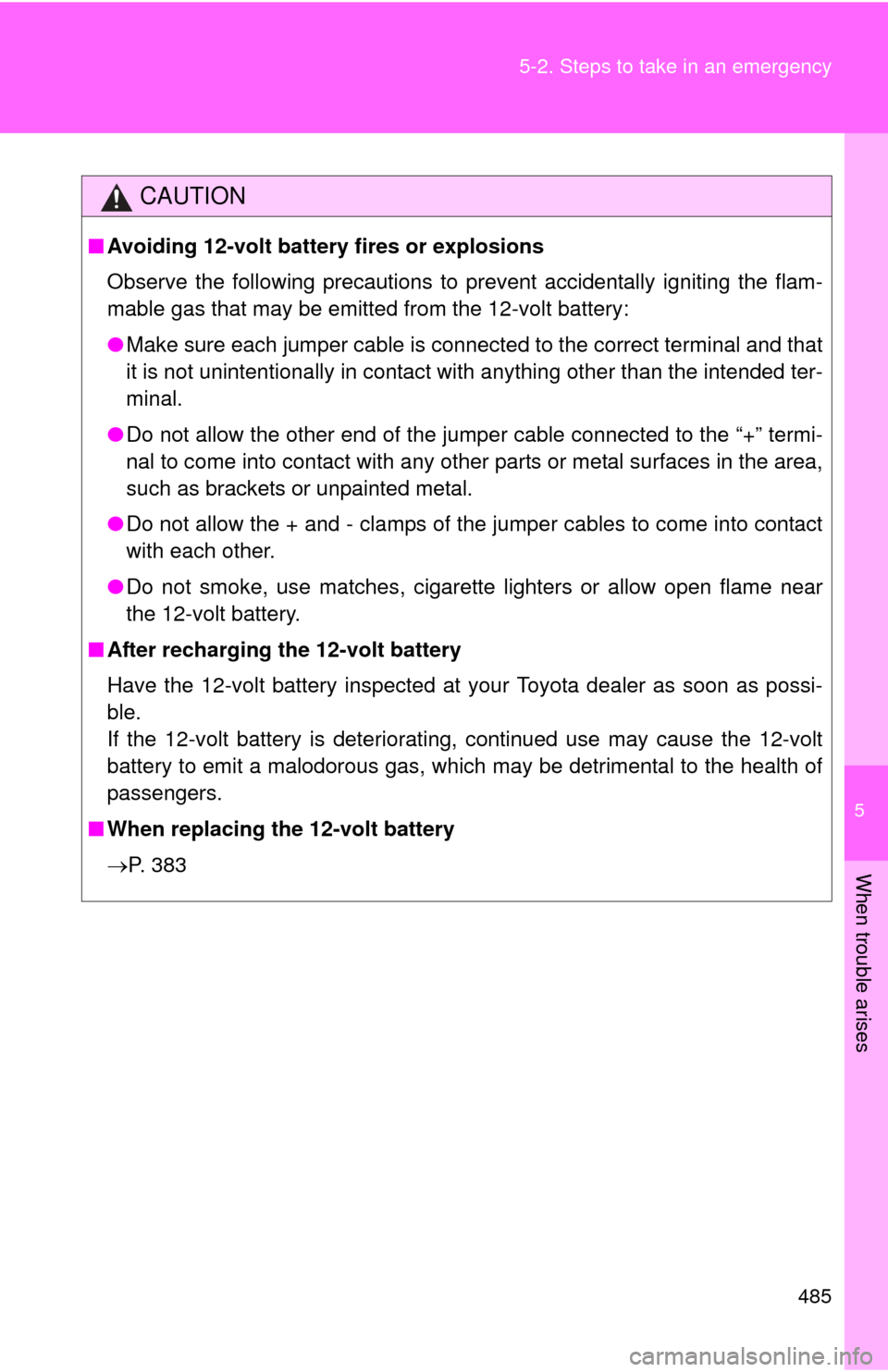Page 486 of 563

5
When trouble arises
483
5-2. Steps to take in an emergency
Start the engine of the second vehicle. Increase the engine
speed slightly and maintain that level for approximately 5
minutes to recharge the 12-v
olt battery of your vehicle.
Vehicles with a smart key system only: Open and close any
of the doors of your vehicle with the “POWER” switch off.
Vehicles without a smart key system
Maintain the engine speed of the second vehicle and start
the hybrid system of your vehicle by turning the engine
switch to the “ON” position.
Vehicles with a smart key system
Maintain the engine speed of the second vehicle and start
the hybrid system of your ve hicle by turning the “POWER”
switch to ON mode.
Make sure the “READY” indicator comes on. If the indicator
does not come on, contact your Toyota dealer.
Once the hybrid system has started, remove the jumper
cables in the exact reverse or der from which they were con-
nected.
Close the exclusive jump starting terminal cover, and rein-
stall the fuse box cover to its original position.
When installing, first hook the fuse box cover onto the two rear
tabs.
Once the hybrid system starts, ha ve the vehicle inspected at your
Toyota dealer as soon as possible.
STEP4
STEP5
STEP6
STEP7
STEP8
STEP9
Page 487 of 563

484 5-2. Steps to take in an emergency
■Starting the hybrid system when the 12-volt battery is discharged
The hybrid system cannot be started by push-starting.
■ To prevent 12-volt battery discharge
●Turn off the headlights and the audio system while the hybrid system is
off.
● Turn off any unnecessary electrical components when the vehicle is run-
ning at a low speed for an extended period, such as in heavy traffic.
■ Precautions when the 12-volt batter y is discharged (vehicles with a
smart key system)
● In some cases, it may not be possible to unlock the doors using the smart
key system immediately after the 12-volt battery has been disconnected
and reconnected. Use the wireless remote control or the mechanical key
to lock or unlock the doors.
● The hybrid system may not start on the first attempt after the 12-volt bat-
tery has recharged but will start normally after the second attempt. This is
not a malfunction.
● The “POWER” switch mode is memorized by the vehicle. When the 12-
volt battery is reconnected, the system will return to the mode it was in
before the 12-volt battery was discharged. Before disconnecting the 12-
volt battery, turn the “POWER” switch off.
If the “POWER” switch was in ACCESSORY or ON mode before the 12-
volt battery was discharged, the audio system and/or air conditioning
system may operate when the 12-volt battery is reconnected.
■ Charging the 12-volt battery
The electricity stored in the 12-volt battery will discharge gradually even
when the vehicle is not in use, due to natural discharge and the draining
effects of certain electrical appliances. If the vehicle is left for a long time, the
12-volt battery may discharge, and the hybrid system may be unable to start.
(The 12-volt battery recharges automatically while the hybrid system is oper-
ating.)
Page 488 of 563

5
When trouble arises
485
5-2. Steps to take in an emergency
CAUTION
■
Avoiding 12-volt battery fires or explosions
Observe the following precautions to prevent accidentally igniting the flam-
mable gas that may be emitted from the 12-volt battery:
●Make sure each jumper cable is connected to the correct terminal and that
it is not unintentionally in contact with anything other than the intended ter-
minal.
● Do not allow the other end of the jumper cable connected to the “+” termi-
nal to come into contact with any other parts or metal surfaces in the area,
such as brackets or unpainted metal.
● Do not allow the + and - clamps of the jumper cables to come into contact
with each other.
● Do not smoke, use matches, cigarette lighters or allow open flame near
the 12-volt battery.
■ After recharging the 12-volt battery
Have the 12-volt battery inspected at your Toyota dealer as soon as possi-
ble.
If the 12-volt battery is deteriorating, continued use may cause the 12-volt
battery to emit a malodorous gas, which may be detrimental to the health of
passengers.
■ When replacing the 12-volt battery
P. 383
Page 504 of 563
501
6-1. Specifications
6
Vehicle specifications
Ignition system
Electrical system
Spark plug
Make
Gap
DENSO FK16R-A8
0.03 in. (0.8 mm)
NOTICE
■
Iridium-tipped spark plugs
Use only iridium-tipped spark plugs. Do not adjust the spark plug gap.
12-volt battery
Open voltage* at
68 F (20 C):
Fully charged
Half charged
Discharged 12.5 V or over
11 . 0
12.5 V
Under
11.0 V
(*: Voltage checked 20 minutes after the hybrid
system and all the lights are turned off)
Charging rates 3.5 A or less
(Recharge within 10 hours)
Page 508 of 563
505
6-1. Specifications
6
Vehicle specifications
Light bulbs
*1: If equipped
*
2: Side turn signal lights should be replaced as an assembly.
A: H11 halogen bulbs B: HB3 halogen bulbs
C: H16 halogen bulbs D: Wedge base bulbs (clear)
E: Wedge base bulbs (amber)
Light bulbsBulb NoWTy p e
Exterior Headlights
Low beam
High beam 9704
900555
60A
B
Parking lights 5D
Front turn signal lights 21 E
Front fog lights*
1 19 C
Tail and rear side marker
lights
5D
License plate lights 5D
Back-up lights 16 D
Side turn signal lights 5E*
2
Front side marker lights 5D
Rear turn signal lights 21 E
Interior Interior lights/personal
lights
5D
Luggage compartment
light*
1 5D
Page 511 of 563

508 6-1. Specifications
■If your engine knocks
●Consult your Toyota dealer.
● You may occasionally notice light knocking for a short time while acceler-
ating or driving uphill. This is normal and there is no need for concern.
NOTICE
■Notice on fuel quality
●Do not use improper fuels. If improper fuels are used, the engine will be
damaged.
● Do not use leaded gasoline.
Leaded gasoline can cause damage to your vehicle’s three-way catalytic
converters causing the emission control system to malfunction.
● Do not use gasohol other than the type previously stated.
Other gasohol may cause fuel system damage or vehicle performance
problems.
● Using unleaded gasoline with an octane number or rating lower than the
level previously stated will cause persistent heavy knocking.
At worst, this will lead to engine damage.
■ Fuel-related poor driveability
If poor driveability is encountered after using a different type of fuel (poor hot
starting, vaporization, engine knocking, etc.), discontinue the use of that type
of fuel.
■ When refueling with gasohol
Take care not to spill gasohol. It can damage your vehicle's paint.
Page 522 of 563

519
6-1. Specifications
6
Vehicle specifications
Intended outboard
sidewall
(a) The sidewall that contains a whitewall,
bears white lettering, or bears manufac-
turer, brand, and/or model name molding
that is higher or deeper than the same
molding on the other sidewall of the tire, or
(b) The outward facing sidewall of an asymmet- rical tire that has a particular side that must
always face outward when mounted on a
vehicle
Light truck (LT) tire A tire designated by its manufacturer as prima-
rily intended for use on lightweight trucks or
multipurpose passenger vehicles
Load rating The maximum load that a tire is rated to carry
for a given inflation pressure
Maximum load rating The load rating for a tire at the maximum per-
missible inflation pressure for that tire
Maximum permissible
inflation pressure The maximum cold inflation pressure to which
a tire may be inflated
Measuring rim The rim on which a tire is fitted for physical
dimension requirements
Open splice Any parting at any junction of tread, sidewall, or
innerliner that extends to cord material
Outer diameter The overall diameter of an inflated new tire
Overall width The linear distance between the exteriors of
the sidewalls of an inflated tire, including eleva-
tions due to labeling, decorations, or protective
bands or ribs
Passenger car tire A tire intended for use on passenger cars, mul-
tipurpose passenger vehicles, and trucks, that
have a gross vehicle weight rating (GVWR) of
10,000 lb. or less.
Ply A layer of rubber-coated parallel cords
Tire related termMeaning
Page 528 of 563
525
6-2. Customization
6
Vehicle specifications
Door lock
(
P. 6 5 )
Unlocking
using a key
Driver's door
unlocked in
one step, all doors
unlocked in two steps All doors
unlocked in one step. —O
Speed-detect-
ing automatic
door lock func-
tion*
2
Off On O O
Opening
driver's door
unlocks all
doors Off
On — O
Shifting gears
to P unlocks all
doors. On
Off O O
Shifting gears
to position
other than P
locks all doors. On
Off O O
Lights
(
P. 204) Daytime run-
ning light sys-
tem (except
Canada)
On Off O O
ItemFunctionDefault set-
tingCustomizedsetting